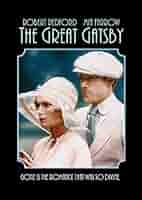The 1974 adaptation of “The Great Gatsby,” directed by Jack Clayton, is widely regarded as one of the most well-known film interpretations of F. Scott Fitzgerald’s classic novel. Starring the charismatic Robert Redford as the enigmatic Jay Gatsby and the talented Mia Farrow as the beautiful yet troubled Daisy Buchanan, this version is particularly notable for its lavish production design and strong performances by the leading actors, who bring a palpable chemistry to their complex roles.
The film beautifully captures the opulence of the Jazz Age, showcasing extravagant parties filled with dazzling costumes and stunning set pieces that vividly illustrate the glamorous lifestyle of the wealthy elite. It features a notable score by composer Nelson Riddle, which significantly adds to the film’s rich atmosphere and emotional depth, enhancing key moments of tension, drama, and romance. The adaptation attempts to remain faithful to the novel’s enduring themes, exploring the pursuit of the elusive American Dream, love, and the moral decay that can accompany immense wealth and privilege.
While the film received mixed reviews at the time of its release, it has since gained a dedicated cult following and is appreciated for its striking visual style, the captivating performances, and the undeniable chemistry between the lead actors. The 1974 adaptation remains a significant part of Gatsby’s cinematic legacy, despite some criticisms regarding pacing, character development, and certain departures from Fitzgerald’s original narrative. Over the years, it has sparked numerous discussions about the complexities of love, ambition, and the consequences of excess, ensuring its enduring place in the annals of film history.


Leave a Reply